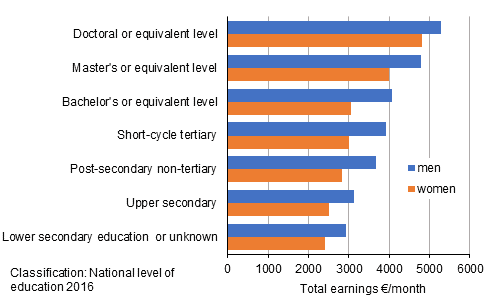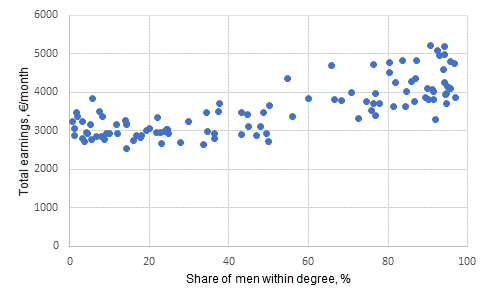Published: 11 October 2021
Median earnings of wage and salary earners were EUR 3,217 per month in 2020
According to Statistics Finland’s Structure of Earnings statistics, the median for total earnings of full-time wage and salary earners was EUR 3,217 per month in 2020. Examined by level of education, wage and salary earners with doctorate level education had the highest total earnings, EUR 5,057. Besides earnings for regular working hours, total earnings also include all bonuses and benefits in kind, but not one-off pay items such as performance or holiday bonuses.
Medians for total earnings of full-time wage and salary earners by level of education in 2020

Level of education has different effects on the wages and salaries of men and women
On average, a higher level of education produces higher pay than a lower level of education. The level of education describes the length and target level of education. Longer education usually also means a higher level of education. More information about the classification of level of education is available here: https://www2.stat.fi/en/luokitukset/koulutusaste/koulutusaste_1_20160101/.
In all main levels of education from upper-level comprehensive school to doctorate level education, the median pay of men exceeds the median pay of women by around 10 to 30 per cent, depending on the level of education. The difference between women’s and men’s median earnings is smallest on the doctorate level. The difference in median earnings is biggest for those with lowest level tertiary qualifications, i.e. post-secondary level qualifications. The commonest group in this level of education is those with a diploma in business and marketing in post-secondary education (education code 531158).
Medians for total earnings of full-time wage and salary earners by level of education and sex in 2020

The reason for different pay levels between men and women with the same level of education is that men and women complete their qualifications in different fields, for example. In addition to the level of education, the field of education and the completed qualification have an effect on pay. Different fields of education and qualifications typically direct people to different tasks, industries and sectors. The differences in total earnings between sexes are also influenced by other factors, such as the length of careers or the amount of extra compensations and overtime related to working hours.
Pay level on average higher in male-dominated fields than in female-dominated fields
On average, the qualifications favoured by men lead to a higher pay level than the qualifications favoured by women. For example, the median earnings of those with lower tertiary education (including vocational tertiary, university of applied sciences and lower university education) show a clear rising trend according to how large a share of those with a certain qualification are men.
The figure below describes as a specific dot each lower tertiary degree with over 250 wage and salary earners in 2020. The median for total monthly earnings and men’s share of wage and salary earners with qualifications have been calculated for each qualification. Qualifications where the share of men is over 80 per cent are mainly engineering degrees in different fields. In female-dominated fields, typical qualifications are those of Bachelor of Social Sciences and public health nurse. A similar correlation exists between men's share and pay in all levels of education after basic level education.
Median for total earnings of lower tertiary degrees and share of men among all completers of qualifications in 2020

Such qualifications where the shares of men and women are even are those attained by environmental technology engineers and paramedics, for example. Men’s earnings were eight per cent higher than those of women with the same qualifications among environmental technology engineers and six per cent higher among paramedics. For these qualifications, the pay differential between women and men is considerably smaller than the average 31 per cent pay differential for all with lower tertiary degrees. In all levels of education, the pay differential between women and men is clearly smaller among those with the same qualifications than inside the level of education.
The data in the release derive from Statistics Finland's Structure of Earnings statistics. The Structure of Earnings statistics for 2020 provide data on the earnings of around 1.4 million full-time wage and salary earners and altogether 1.7 million full-time and part-time wage and salary earners. The Structure of Earnings statistics describe all wage and salary earners for the public sector and those working in enterprises with more than five employees for the private sector. The top management of private sector enterprises is excluded from the statistics.
The earnings data released in the statistics are total earnings. Apart from earnings for regular working hours, total earnings also include pay for any possible overtime and working hour supplements, premium pays, supplement for location and adverse working conditions, supplements based on duties, professional skill and years of service, performance-based pay components, compensation for standby and on-call work and benefits in kind, but not one-off pay items, such as performance-based bonuses. Total earnings are in gross, so taxes or other payments have not been subtracted from them.
Source: Structure of Earnings 2020, Statistics Finland
Inquiries: Hanna Jokimäki 029 551 3333, Matti Lahdenmäki 029 551 3690, palkkarakenne@stat.fi
Head of Department in charge: Hannele Orjala
Publication in pdf-format (226.2 kB)
- Tables
-
Tables in databases
Pick the data you need into tables, view the data as graphs, or download the data for your use.
Appendix tables
Updated 11.10.2021
Official Statistics of Finland (OSF):
Structure of Earnings [e-publication].
ISSN=1799-0092. 2020. Helsinki: Statistics Finland [referred: 8.1.2026].
Access method: http://stat.fi/til/pra/2020/pra_2020_2021-10-11_tie_001_en.html

